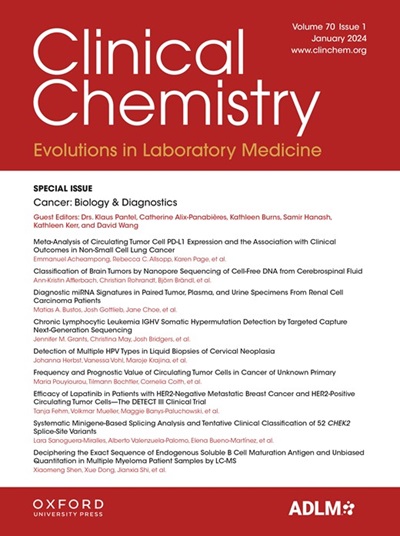B-016 Evaluation of pyridoxamine phosphate (PAMP) for AST/ALT reagents with recombinant human apoenzymes
IF 7.1
2区 医学
Q1 MEDICAL LABORATORY TECHNOLOGY
引用次数: 0
Abstract
Background ApoAST/ALT, which have lost a coenzyme such as pyridoxal phosphate (PALP), are normally present at low levels in serum. To form the holoenzyme, IFCC recommends adding PALP into AST/ALT reagents. However, commercial reagents often do not use PALP due to its instability. In recent years, pyridoxamine phosphate (PAMP), a more stable coenzyme, has been marketed. However, the differences in holo formation ability and reagent stability between their coenzymes are not well understood. In this study, we focused on the preparation of PAMP and recombinant human ApoAST/ALT (rhApoAST/ALT), followed by fundamental investigations into their use as AST/ALT reagents. Methods PAMP was synthesized from pyridoxamine through an enzymatic reaction using pyridoxal kinase. The reaction product was purified to achieve a purity of >99% in HPLC. rhApoAST/ALT were expressed in Escherichia coli and purified with chromatography. AST/ALT assay was performed on a Hitachi 7180 automatic analyzer. PALP reagents for AST/ALT were designed to correspond with the final concentration of the IFCC method. PAMP reagents were prepared with PAMP instead of PALP. To evaluate the holo formation ability of PALP and PAMP reagents, we measured a dilution series of rhApoAST/ALT. To assess stability, the reagents were stored at 11°C for 3 months and then measured same. The reagents were subjected to content analysis by HPLC. Results Similar results were shown between coenzymes in the evaluation of holo formation ability, and high correlations were observed. As for the stability test, the values of PALP reagents decreased after 3 months, while the values of PAMP reagents did not. Content analysis showed that a spontaneous transamination occurred in PALP reagents. These results were observed at both AST and ALT reagents. Conclusions In AST/ALT reagents, both PAMP and PALP can activate apoenzymes. While PAMP is stable, PALP causes a decrease in reagent performance due to a spontaneous transamination.B-016 用重组人载脂蛋白酶对磷酸吡多胺(PAMP)进行 AST/ALT 试剂评估
背景载脂蛋白AST/ALT失去了磷酸吡哆醛(PALP)等辅酶,通常在血清中含量较低。为形成全酶,IFCC 建议在 AST/ALT 试剂中加入 PALP。然而,由于 PALP 不稳定,商业试剂通常不使用 PALP。近年来,一种更稳定的辅酶--磷酸吡多胺(PAMP)已经上市。然而,人们对这两种辅酶在全合成能力和试剂稳定性方面的差异还不甚了解。在本研究中,我们重点研究了 PAMP 和重组人载脂蛋白AAST/ALT(rhApoAST/ALT)的制备,然后对它们作为 AST/ALT 试剂的用途进行了基础研究。方法 使用吡哆醛激酶通过酶促反应从吡哆胺合成 PAMP。在大肠杆菌中表达 rhApoAST/ALT,并用色谱法纯化。AST/ALT 检测在日立 7180 自动分析仪上进行。用于检测 AST/ALT 的 PALP 试剂是根据 IFCC 方法的最终浓度设计的。PAMP 试剂用 PAMP 代替 PALP 制备。为了评估 PALP 和 PAMP 试剂的整体形成能力,我们测量了 rhApoAST/ALT 的稀释系列。为了评估试剂的稳定性,我们将试剂在 11°C 下储存 3 个月,然后进行相同的测定。试剂通过 HPLC 进行含量分析。结果 在整体形成能力的评估中,不同辅酶之间显示出相似的结果,并观察到高度的相关性。在稳定性测试中,PALP 试剂的值在 3 个月后下降,而 PAMP 试剂的值没有下降。含量分析表明,PALP 试剂中出现了自发的转氨作用。这些结果在 AST 和 ALT 试剂中均可观察到。结论 在 AST/ALT 试剂中,PAMP 和 PALP 都能激活载脂蛋白。PAMP 比较稳定,而 PALP 则会因自发的转氨作用而导致试剂性能下降。
本文章由计算机程序翻译,如有差异,请以英文原文为准。
求助全文
约1分钟内获得全文
求助全文
来源期刊

Clinical chemistry
医学-医学实验技术
CiteScore
11.30
自引率
4.30%
发文量
212
审稿时长
1.7 months
期刊介绍:
Clinical Chemistry is a peer-reviewed scientific journal that is the premier publication for the science and practice of clinical laboratory medicine. It was established in 1955 and is associated with the Association for Diagnostics & Laboratory Medicine (ADLM).
The journal focuses on laboratory diagnosis and management of patients, and has expanded to include other clinical laboratory disciplines such as genomics, hematology, microbiology, and toxicology. It also publishes articles relevant to clinical specialties including cardiology, endocrinology, gastroenterology, genetics, immunology, infectious diseases, maternal-fetal medicine, neurology, nutrition, oncology, and pediatrics.
In addition to original research, editorials, and reviews, Clinical Chemistry features recurring sections such as clinical case studies, perspectives, podcasts, and Q&A articles. It has the highest impact factor among journals of clinical chemistry, laboratory medicine, pathology, analytical chemistry, transfusion medicine, and clinical microbiology.
The journal is indexed in databases such as MEDLINE and Web of Science.
 求助内容:
求助内容: 应助结果提醒方式:
应助结果提醒方式:


